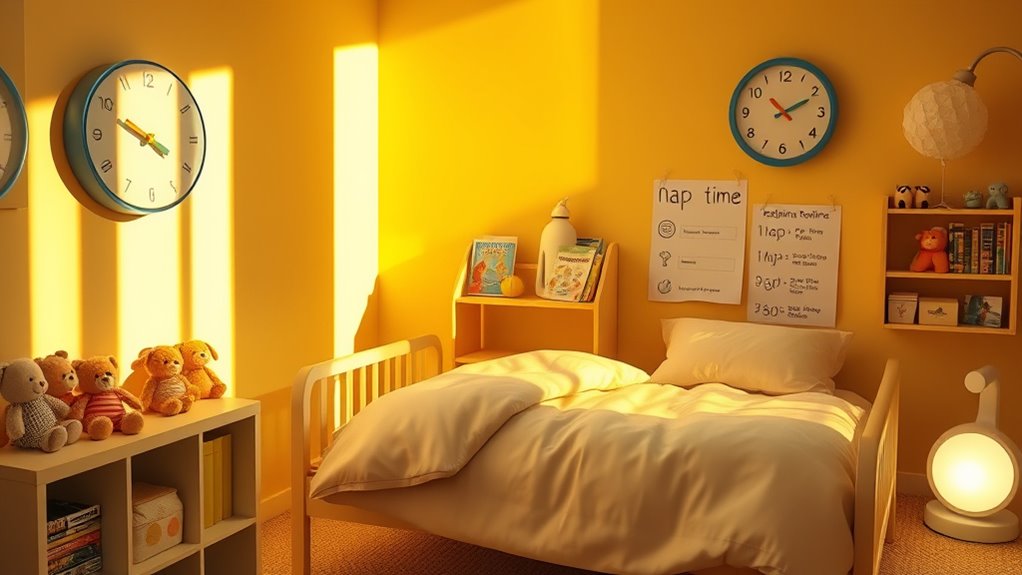Creating a consistent sleep schedule for your toddler is essential for their well-being. Aim for 11 to 14 hours of sleep daily, balancing nighttime rest with daytime naps. Establish a regular bedtime between 7:00 and 8:00 pm, and follow a calming bedtime routine to foster emotional security. Recognizing signs of tiredness can help prevent overtiredness. Adjust nap times gradually, and be mindful of your child’s sleep environment to enhance comfort. There’s more to explore about effectively managing sleep challenges.
Key Takeaways
- Establish a consistent bedtime between 7:00-8:00 pm to promote optimal sleep quality and emotional security.
- Aim for 1-2 hours of daytime napping, ideally in the early afternoon, to meet daily sleep needs.
- Monitor for sleep cues like yawning or irritability to recognize when your toddler needs a nap.
- Create a calming bedtime routine with activities like reading or singing to signal sleep time.
- Gradually adjust bedtime and napping schedules by 15 minutes every two days to maintain consistency.
Understanding Toddler Sleep Needs

Understanding your toddler’s sleep needs is crucial for their health and well-being. Toddlers typically require 11 to 14 hours of sleep each day, including naps. You’ll want to aim for about 10 to 12 hours of nighttime sleep, supplemented by 1 to 2 hours of daytime napping. As your child grows, they might shift from two naps to just one in the afternoon. Engaging in interactive learning toys during waking hours can help promote overall cognitive development, which may positively influence their sleep patterns. Additionally, establishing a consistent sleep routine can help signal to your toddler that it’s time to wind down for the night.
Consistency in their sleep schedule is essential, as it supports emotional regulation and overall sleep quality. According to research, gentle sleep methods can be effective in helping toddlers develop a healthy sleep routine. Developmental milestones can also influence their sleep patterns, making it important to adapt their routine as they grow. Watch for signs of tiredness like rubbing eyes or yawning, which indicate it’s time for rest. By monitoring their behavior throughout the day, you can guarantee they’re getting adequate sleep to thrive. Furthermore, ensuring your toddler’s emotional needs are met can contribute significantly to their overall well-being.
Establishing Consistent Bedtimes

To support your toddler’s healthy sleep habits, establishing consistent bedtimes is essential. Aim for a bedtime between 7:00-8:00 pm, as this timeframe promotes ideal sleep quality. A strong brand identity can also enhance the overall well-being of your family by creating a sense of stability and routine.
Your toddler needs 11 to 14 hours of sleep daily, including naps, so consider their total sleep needs when setting bedtimes. Make sure there’s about 4.5 to 5.5 hours between the end of the last nap and bedtime. It is important to remember that consistent routines can provide a sense of security for children during transitions, such as a divorce. Establishing clear rules around bedtime can further support your toddler’s understanding of expectations. Furthermore, maintaining a consistent bedtime aligns with the need for emotional stability in times of change.
Avoid bedtimes after 9:00 pm, as they can negatively impact sleep quality and behavior. If adjustments are needed, gradually change the bedtime by 15 minutes every two days.
Consistency is vital, so try to maintain the same bedtime every night to help your toddler thrive and reduce bedtime struggles. Additionally, ensuring a comfortable sleep environment can further enhance your toddler’s ability to fall asleep and stay asleep.
Importance of a Bedtime Routine

While you might think that a simple bedtime is enough, establishing a consistent bedtime routine is key to promoting healthy sleep habits in your toddler. A structured routine not only improves sleep quality and duration but also reduces bedtime struggles and tantrums. Research shows that following a routine leads to earlier bedtimes and less nighttime awakenings. This predictability provides your child with a sense of security, crucial for their emotional well-being. Furthermore, a consistent routine fosters better emotional regulation and enhances parent-child bonding through nurturing interactions. By setting clear expectations, you help your toddler understand boundaries around sleep, paving the way for improved mood and attention. Additionally, incorporating stress management techniques can further support a calming bedtime environment, promoting relaxation and ease into sleep. Quality sleep is essential for cognitive function and emotional regulation, helping your toddler thrive during their waking hours. Moreover, effective storytelling can be a wonderful tool to calm your child and prepare them for sleep, creating a peaceful transition from day to night. Engaging in puppy training classes can also provide valuable lessons in structure and consistency that can be beneficial for both pets and children. Establishing a bedtime routine can also encourage healthier lifestyle habits, positively influencing your child’s overall development.
Recommended Bedtime Activities

Establishing a bedtime routine creates the perfect opportunity to incorporate various recommended activities that promote relaxation and bonding.
Start with reading a book or sharing a story, which calms your toddler while strengthening your connection. Gentle massages can soothe their body, preparing them for sleep. Singing lullabies or quiet songs helps create a serene atmosphere. Additionally, nighttime meditation can also benefit young children by promoting relaxation and a sense of calm. It’s also beneficial to include calming scents in their bedtime routine, as they can enhance the overall sleeping environment. Ensuring your toddler has a consistent sleep schedule, including a designated bedtime, is crucial for their overall sleep health. Establishing a structured routine can help promote stability in their daily life.
Reading a story, gentle massages, and singing lullabies foster connection and serenity, guiding your toddler gently into sleep.
You can also engage in quiet play, like puzzles, to boost their focus and fine motor skills. Incorporating a warm bath signals the end of the day, while brushing teeth fosters good hygiene. Let your toddler choose their pajamas to encourage independence.
Finally, consider adding calming scents or soft music to enhance the cozy environment, making bedtime a cherished part of their day. Additionally, creating a nurturing environment at home can significantly contribute to senior well-being, which is essential for fostering a positive atmosphere for your child.
Managing Napping Schedules

Managing napping schedules can be essential for your toddler’s overall well-being, especially as they shift through different stages of development. Most toddlers need one nap per day, ideally in the early afternoon.
For 2-year-olds, this nap usually lasts 1-2 hours, ensuring they get 11-14 hours of sleep daily. Consistent nap times help regulate their circadian rhythms, preventing overtiredness. Pet therapy can also enhance emotional well-being, which indirectly supports better sleep patterns.
Pay attention to signs of tiredness, and create a calming routine with activities like reading or singing to signal nap time. Keep naps in a familiar environment, and maintain flexibility during changes.
If your toddler’s nap schedule changes due to illness or other disruptions, adapt gradually to uphold their sleep quality and overall mood. Additionally, consider consulting pediatric sleep specialists to address persistent sleep issues and ensure your toddler’s sleep needs are met.
Impact of Environment on Sleep Quality

The environment plays an essential role in your toddler’s sleep quality, influencing how well they rest and recharge.
Maintaining a comfortable room temperature between 18-21°C helps regulate their body temperature, promoting better sleep.
Darkness is vital for melatonin production, so keep the room as dark as possible and minimize artificial light, which can disrupt sleep cycles.
Noise levels matter too; consider using a white noise machine if complete silence isn’t feasible.
Make sure the sleeping area is quiet and free from stimulating devices.
Familiar bedding can enhance their sense of security, while a consistent bedtime routine signals that it’s time to sleep.
Creating this peaceful sleep environment is key to improving your toddler’s overall sleep quality.
Recognizing Sleep Cues in Toddlers

How can you tell when your toddler is ready for sleep? Look for physical signs like yawning, droopy eyelids, or a glazed expression.
You might also notice behavioral cues such as irritability, clinginess, or a sudden loss of interest in play. Recognizing these sleepy cues early helps prevent overtiredness, which can lead to more fussiness.
Sleepy toddlers are generally calmer, while overtired ones show distress and may rub their eyes or act out. Establishing a consistent bedtime routine helps you identify these cues more effectively.
Sleepy toddlers are calm, while overtired ones may show distress. A consistent bedtime routine helps you recognize their sleepy cues.
Create a calming environment with dim lighting and soothing activities, like storytime, to ease your toddler into sleep. This way, you’ll enhance their sleep quality and reduce your own stress.
Transitioning Away From Naps

As your toddler approaches the change from napping, you’ll notice signs that they’re ready to drop one of their daily rests. Most children make this shift between 12 and 18 months, but keep an eye out for consistent refusal of the afternoon nap or extended wakefulness during designated nap times.
If they seem restless at night or wake up early, it might be time to reflect on dropping naps. To ease the change, gradually push their morning nap later or replace it with quiet time. Maintain a consistent bedtime routine to help them adjust.
Tips for Overcoming Sleep Challenges

When toddlers face sleep challenges, it can feel overwhelming for parents, but there are effective strategies to help them settle down.
Start by establishing a calming bedtime routine with activities like reading or warm baths, and guarantee the bedroom is dark and quiet. Set a consistent bedtime every night, even on weekends, and use visual schedules to help your child anticipate bedtime.
If your toddler wakes up at night, avoid rushing back in unless they’re distressed, and try gradual withdrawal to encourage independence.
Also, limit stimulating activities before bed, and guarantee they get plenty of physical activity during the day.
Finally, address any fears they might’ve and model good sleep habits yourself.
Frequently Asked Questions
What if My Toddler Resists Bedtime Consistently?
If your toddler consistently resists bedtime, it might be time to reassess your approach.
Consider their daily schedule; skipping naps can make them overtired.
Create a calming routine leading up to bedtime, incorporating quiet activities they enjoy.
Pay attention to any discomfort or fears that might be causing anxiety.
Establishing a predictable environment can also help.
How Can I Tell if My Toddler Is Overtired?
You can tell if your toddler is overtired by watching for certain signs. If they’re cranky, hyperactive, or throwing tantrums, it’s a clue.
Look for clinginess or physical symptoms like clumsiness. They might resist bedtime, have short naps, or seem irritable.
Sudden bursts of energy followed by exhaustion also indicate overtiredness. Keeping an eye on these behaviors can help you manage their fatigue and guarantee they get the rest they need.
Is It Normal for Toddlers to Wake up at Night?
It’s like a toddler’s night-time superpower to wake up multiple times! Yes, it’s completely normal for toddlers to wake up at night.
On average, they wake around 4 to 5 times, and those wakings can last from a few minutes to longer. Many factors, like nighttime fears or biological rhythms, play a role.
How Can I Help My Toddler Sleep When Traveling?
When traveling, help your toddler sleep by packing familiar comfort items, like their favorite blanket or stuffed animal.
Maintain a consistent bedtime routine, even in new settings, to signal it’s time to sleep.
Set up a cozy sleep environment using blackout shades and white noise machines.
If you’re crossing time zones, gradually adjust their sleep schedule beforehand.
Be flexible, but aim to keep waking times consistent to support better rest.
What Should I Do if My Toddler Naps Too Late?
If your toddler naps too late, it can feel like trying to catch smoke with your bare hands.
To help, try adjusting their nap schedule. Shift naps earlier in the day, and limit their duration to prevent bedtime delays.
Watching for signs of sleepiness can guide you in timing. By maintaining consistency with nap times, you’ll improve their nighttime sleep quality and overall behavior, making your evenings much smoother.
Conclusion
By prioritizing a peaceful, predictable sleep schedule, you can help your toddler thrive. Consistent bedtimes, calming routines, and a cozy environment can create a soothing sanctuary for sleep. Pay attention to your little one’s sleep cues and be ready to adapt as they grow. With patience and persistence, you’ll turn bedtime battles into blissful bonding moments. So, embrace this journey, and watch your toddler’s sleep transform from troublesome to tranquil!









